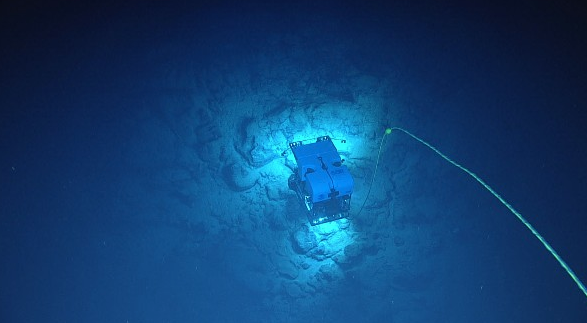During a recent expedition on the National Oceanic and Atmospheric Administration’s ship Okeanos Explorer, an engineer on shore, over 1,000 miles away from the ship, successfully piloted a remotely operated vehicle (ROV) to explore the deep ocean. A first for NOAA Ocean Exploration and the Global Foundation for Ocean Exploration, this test of piloting an ROV from shore opens new possibilities for deep-ocean exploration.
“Telepresence technology has been a game changer for deep-ocean exploration,” NOAA officials said. “It changed who could participate, and when, how, and from where they could do so. First, we used it to engage scientists from shore in real time, then we used it to invite the public into deep-ocean exploration, and finally we used it to conduct mapping operations from shore.”
On March 1, 2022, during NOAA Ocean Exploration’s 2022 ROV and Mapping Shakedown on NOAA ship Okeanos Explorer, with all other objectives having been met, engineers from the Global Foundation for Ocean Engineering (GFOE) turned their attention to a new use of telepresence: piloting remotely operated vehicle (ROV) Deep Discoverer from shore. From Rhode Island, specifically, approximately 2,575 kilometers (1,600 miles) away from the ROV in the depths of the Straits of Florida.
During the test, a shoreside GFOE engineer, piloted the ROV for more than an hour of typical exploration activity over a boulder field in an unexplored canyon on the West Florida Shelf. The test required a coordinated effort between the shoreside pilot and the shipboard team of ROV engineers, officers, and scientists to determine and control ship moves and the camera and ROV manipulator arm functions required for the imaging and geological sampling typically performed during a dive.
“The ability to pilot the ROV from a shoreside location is the result of a team of very talented engineers who worked together to overcome the multiple challenges necessary to make this possible,” said Dave Lovalvo, GFOE president. “GFOE is excited about the development of this capability and continues to advance our technology in the field of deep-ocean robotics.”
Earlier efforts to improve the telepresence capabilities aboard Okeanos Explorer have resulted in a significant reduction in the communication delay between ship and shore. During the recent test, the shoreside engineer was able to initiate ROV movements and actions (e.g., imaging and sampling) from shore and view the ROV’s response in the livestreamed video, taken 1,800 meters (5,906 feet) underwater, in a mere 1.25 seconds. This is remarkable considering that the signals have to travel approximately 70,811 kilometers (44,000 miles) to a satellite in space and then back to Earth, twice (action input and video response).
“As a national leader in ocean exploration, it’s NOAA Ocean Exploration’s responsibility to push the boundaries of what’s possible for deep-ocean exploration,” said Jeremy Weirich, director of NOAA Ocean Exploration. “Our future depends on the ocean, and new and evolving technologies are critical to helping us better understand it, protect it, and manage its many uses. The ability to pilot an ROV from shore is full of promise and just one of many technological advancements that we have supported through partnerships with organizations like GFOE.”
The test in March was just the second test of this evolving capability, and the first that the partners tested in the deep ocean. GFOE first tested its shoreside piloting capability in Yellowstone National Park’s Yellowstone Lake in August 2021, a collaboration between NOAA Office of Marine and Aviation Operations and GFOE. During the Yellowstone testing, GFOE piloted its ROV Yogi from shore in Rhode Island and also developed the capability to operate its research vessel Annie in autonomous mode, enabling the ship to automatically follow Yogi during a dive.
Ocean exploration has relied on the use of ROVs for more than 30 years. But, how NOAA operates them hasn’t changed much. For example, during ROV operations conducted by NOAA Ocean Exploration and GFOE on Okeanos Explorer, shipboard engineers, who are needed to operate and maintain the ROV and related systems, typically comprise a relatively large percentage of the science team.
After years of telepresence upgrades and technological and staff development, the successful demonstration of shoreside ROV piloting is a significant accomplishment that has broad implications for the future of deep-ocean exploration.
Shoreside ROV piloting provides opportunities for engineers on shore who may be unable to go to sea and for the training of new ROV engineers. It also provides redundancy in case of emergency and may eventually free up valuable ship berths to expand science teams in new directions.
NOAA Ocean Exploration is the only federal program dedicated to exploring the deep ocean. By leading national efforts to explore the planet’s oceans and making ocean exploration more accessible, NOAA Ocean Exploration is filling gaps in the basic understanding of U.S. deep waters and the seafloor, providing critical deep-ocean data, information, and awareness needed to sustain and accelerate the U.S.’s economy, health, and security.
The Global Foundation for Ocean Exploration (GFOE) is a nonprofit foundation whose primary mission is to develop the capabilities and foster the relationships necessary to be a global presence in the world of ocean exploration. GFOE works to empower the underwater science community with the tools and expertise required to explore the greatest depths of the planet’s largest and deepest bodies of water and trains the ocean exploration workforce.




